has 13+ years experience in web development, ecommerce, and internet marketing. He has been actively involved in the internet marketing efforts of more then 100 websites in some of the most competitive industries online. John comes up with truly off the wall ideas, and has pioneered some completely unique marketing methods and campaigns. John is active in every single aspect of the work we do: link sourcing, website analytics, conversion optimization, PPC management, CMS, CRM, database management, hosting solutions, site optimization, social media, local search, content marketing. He is our conductor and idea man, and has a reputation of being a brutally honest straight shooter. He has been in the trenches directly and understands what motivates a site owner. His driven personality works to the client's benefit as his passion fuels his desire for your success. His aggressive approach is motivating, his intuition for internet marketing is fine tuned, and his knack for link building is unparalleled. He has been published in books, numerous international trade magazines, featured in the Wall Street Journal, sat on boards of trade associations, and has been a spokesperson for Fortune 100 corporations including MSN, Microsoft, EBay and Amazon at several internet marketing industry events. John is addicted to Peets coffee, loves travel and golf, and is a workaholic except on Sunday during Steelers games.

There’s an old adage in international marketing circles that says to go global, businesses really have to think local.
Apple recently launched its ubiquitously popular iPhone in China and after more than two months, it had shifted a mere 5,000 handsets. Whilst it is a product that will be unaffordable to many people in China, in a country of more than one billion people, most conservative forecasts of iPhone’s two-month sales figures prior to launch would be at least fifty times that.
Apple failed to consider a number of factors when launching the iPhone, namely Chinese consumers prefer not to sign long-term contracts, opting for charge cards instead, allowing a greater degree of flexibility for the user. This isn’t the only reason it hasn’t taken off, but it’s a factor that Apple really should have considered prior to launch – they should’ve properly researched the market.
At a micro level, it’s easier than ever for the smallest of home-built businesses to network and trade on the international arena. But the first step towards doing so is to build a fully localized presence in your key target markets– and the process begins with adapting your company website for each country you plan to tap into.
Like Apple should’ve done with the iPhone, you need to fully understand your target country, know what excites them and what, ultimately, is likely to encourage them to part with their hard-earned cash.
 The only way businesses should communicate with their international markets is in the native language of the local consumers. Even though English is the most commonly spoken second language in the world, the fact remains that people prefer to communicate in their mother tongue. Furthermore, three quarters of the world’s population speak no English whatsoever.
The only way businesses should communicate with their international markets is in the native language of the local consumers. Even though English is the most commonly spoken second language in the world, the fact remains that people prefer to communicate in their mother tongue. Furthermore, three quarters of the world’s population speak no English whatsoever.
Contrary to what many people think, fluency in a particular language doesn’t qualify someone to translate into it. To provide convincing translations, the translator requires first-hand knowledge of the culture of that language which is why most translators will only ever work INTO their native tongue from another language in which they are fluent.
Furthermore, many linguists will specialize in a particular subject – such as marketing, engineering or agriculture. If your company’s products or services involve highly technical terminology, you will probably want to consider checking with the translation company that they have suitable candidates with the right level of experience.
The important thing to remember when translating your website or any other marketing material is that what works in one country, might not translate the way you want it to in another. What’s clever and witty in one country, might be offensive in another. This is something only a native-speaking translator will know.
It’s also important to be wary of dialects within languages. If you translate your website into French, it doesn’t mean you can use it for all French-speaking countries.
In France, a ‘post-office box’ is a boîte postale, but in Belgium and Switzerland it’s a case postale. In France, ‘lunch’ is déjeuner, but in Belgium and Switzerland the word for ‘lunch’ is dîner which, incidentally, is the word for ‘evening meal’ in France. There is a whole host of linguistic nuances between the French, German and Portuguese dialects of the world. Even closer to home, the English in the US and the English in the UK are significantly different…not to the point of requiring an entirely different website, but certainly to the point of requiring significant care and attention when writing the English text.
When marketing internationally, the words ‘language’ and ‘local’ should always go hand-in-hand. Failing to do so can lead to a very costly global venture for businesses where funds may be limited.
About the Author
Article by Christian Arno, the Managing Director of Lingo24.
Visit Christian’s website at www.lingo24.com.

Press release websites can be one of many search engine optimization tactics for your website. They give you back links, and will reach people that you wouldn’t reach otherwise. There are a number of paid websites like PR.com, Marketwire, and PRweb. Just as an example, PRweb (shown in the first screen shot) offers two levels of visibility, high visibility, which costs $199 a year, or platinum, which costs $499 a year.
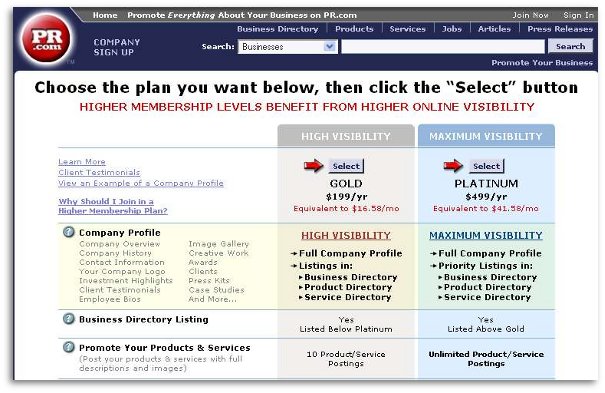
Are these services worth it? Only you can answer that. It will depend on your budget and on whether you think the investment will pay off in terms of higher ad revenue on your site or better conversion rates. Paid PR websites offer company profiles listed in various directories, plus paid and free press release distribution, and anchor text links.
When you write press releases, whether for paid or free PR sites, always write for your audience. Targeted traffic is what you want. Have you ever found blog posts with very provocative titles that turn out to be about something else completely? That’s not what you want to do with press releases. You have to be genuine. After all, if you have great content, the people who visit are more likely to stick around, bookmark your site, and generate lots of page views.
That said, use the anchor text and headline in a press release to focus on your targeted keywords. Use the headline to focus on one of your primary keywords, and use links sprinkled throughout the press release. If the PR site you’re using gives you a resource box, an “About Us” page, or a profile, these are all good places to provide a link to your home page. Use the links within the press release to link to more specific, relevant content.
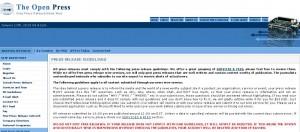 Theopenpress.com (see second screen shot for some of their guidelines) is a free service as long as you follow their guidelines to the letter. They don’t edit free press releases, so if the ones you submit don’t meet the guidelines, they simply delete them.
Theopenpress.com (see second screen shot for some of their guidelines) is a free service as long as you follow their guidelines to the letter. They don’t edit free press releases, so if the ones you submit don’t meet the guidelines, they simply delete them.
PR Leap has free and paid services that kick out your press release where it can be seen by bloggers, consumers, and journalists, reaching all the main search engines, news websites, and newswires.
PR Inside is another free press release service. You create a free account to submit press releases. The home page is a repository for the latest press releases, which are not catagorized. It’s free, and no doubt has a lot of readers, but the right person seeing your press release appears to be largely a matter of coincidental timing, so this shouldn’t be your sole press release outlet.
i-newswire.com allows free press releases to be submitted as long as they aren’t spammy (“Buy Our Awesome Software Today!” and the like). Free press releases are not allowed to have any graphics or links in them. This site also has paid accounts, which offer more perks.
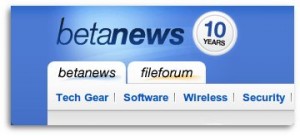 betanews.com is a tech-oriented news site that you can join for free and submit content to. It caters to IT professionals, programmers, site designers, computer security, and relevant legal issues.
betanews.com is a tech-oriented news site that you can join for free and submit content to. It caters to IT professionals, programmers, site designers, computer security, and relevant legal issues.
If you’re interested in comparing several paid and free press release websites side by side, Star Reviews has such a comparison here.
The general idea behind using press release websites is that you should exhaust all the free possibilities before going to a fee-based service, unless you just have a generous budget to begin with, which most people don’t.
Perhaps the most important rule for writing press releases is to make them newsworthy. People and press release sites are good at filtering out the so-called press releases that are actually sales pitches. You might have something they’re interested in, but if their first impression is “spam press release,” they’ll scroll right on by it.
If you don’t know how to write a press release, or don’t think you’d do a good job, there are plenty of copywriters out there willing to do it for you. You may be able to find someone who has written for the very sites you want to send the release to.
Since most free press release sites require you to create an account, go ahead and register with several of them at once – at least 10 or 12. That way when you have your press release ready to go, all you have to do is copy and paste it properly for each press release site. Proofread press releases meticulously before submitting them. Some sites won’t let you change press releases after they’ve been submitted, and you don’t want to be the guy advising software buyers to “be perpared.”
If the site allows graphics, audio, or video, and if you have it, be sure to include it. Keep track of the places you submitted your press release to and whether or not people read it. You can do this in a spreadsheet if you’re the organized type, or you can use a simple pen and paper to keep track, but you need to do this so you’ll know which sites give you the most exposure for your time and effort.
Learn when to hold back. Once or twice a month is a good frequency with which to send out press releases. Once a day is overkill and people will rapidly come to recognize your press releases and ignore them. Once you find the sites that you like best, it’s a good idea to stagger your releases. If you submit to ten sites in one day, it will scroll off of ten sites pretty much at the same time. If you stagger your press releases, you’ll have them on at least one site at all times.

Google Merchant Center is for those who want to submit products and sell them through Google. It used to be called Google Base. Google Merchant Center is where you upload feeds, check item status, and get information about how well your listings are doing. Your products uploaded to Google Merchant Center feed the searches that other people do for products they want to buy. For example, suppose someone wants to buy some dog toys. Starting at Google’s home page and clicking on “Shopping,” they’ll see a page like in the first screen shot. After typing “dog toys” into the search box and hitting enter they’ll be taken to a listings page like the one in the second screen shot.
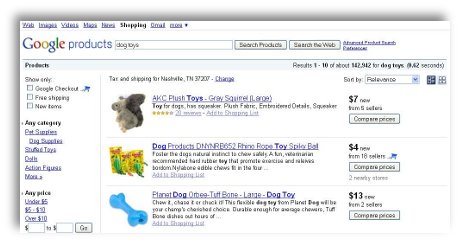

Google Base still exists, but Google Merchant Center is optimized for product listings, and it is where Google will concentrate on adding features and improving the tools needed for uploading product listings and managing them. If you already used Google Base for listing products, your existing data feeds, FTP settings, and other items will still be there. Your account will have already been transferred to the Google Merchant Center, and you will sign in using the same account you used on Google Base. For most users the transfer will be transparent. There are, however, a small fraction of users who have been uploading product listings and other items on Google Base. They will need to sign on to Google Base to create new FTP settings to be able to upload non-product feeds to Google Base.
 Google Merchant Center has a new dashboard page that contains an overview of your product listings, and feeds, and performance graphs, making them more accessible than before. There is now a blog you can visit, googlemerchantblog.blogspot.com for news and tips for using Google Merchant Center effectively.
Google Merchant Center has a new dashboard page that contains an overview of your product listings, and feeds, and performance graphs, making them more accessible than before. There is now a blog you can visit, googlemerchantblog.blogspot.com for news and tips for using Google Merchant Center effectively.
If you sell items over Google Merchant Center, the Google Checkout is the secure web application that lets you process orders, which includes tasks like charging credit cards, specifying carriers and tracking numbers, canceling or refunding orders, reviewing payout summaries, and updating Google Checkout settings.
To process orders in the Google Merchant Center, you sign in, review the order, and charge the buyer’s credit card. Google will then authorize 100% of the order amount. You are required to charge the order within seven calendar days to be guaranteed the funds. After the order is charged, you automatically initiate the payout process. You have to ship the order within a specified time frame that you agreed to when you confirmed an order so that you will be eligible for the Google Checkout Payment Guarantee. You’ll notify the buyer that their order has shipped. There are ways of automating order processing using the Google Checkout API.
If you sell services or goods that don’t need to be physically shipped, you have to mark the order “shipped” in order to send the buyer a confirmation email. Some transactions involving digital goods might not be covered under the Google Checkout Payment Guarantee policy.
In processing orders, Google uses automatic fraud risk modeling to alert them to possible fraudulent transactions. If a fraudulent transaction is detected, it is immediately cancelled. In order to protect you and other Google Merchants, active orders from the same fraudulent credit card will be cancelled. Google Merchant also uses industry sources like worldwide fraud blacklists to block fraudulent shoppers from using Google Checkout in the first place.
For example, if Google detects suspicious activity related to one of your orders, it will flag the order with “customer review in progress” status and will perform fraud detection tests on the order to keep your risk as low as possible. Google usually completes their reviews in four to six hours.
You, as a Google Merchant, are able to review credit verification information on each order you receive. You just sign in to Google Checkout, click the order in which you are interested in your “orders” box. At that time buyer credit verification information appears below the buyer’s shipping information, including whether the transaction is covered by the Payment Guarantee, the Address Verification System check, the Card Verification Value, or CVV, and Account age shows how long the buyer has been qualified to buy through Google Checkout. If you are concerned about an order, you do have the option to cancel it to avoid the risk of a fraudulent transaction.
Fees for Google Merchants vary by the dollar amount of monthly sales and are reset every month on the 5th. For monthly sales under $3,000, the fee is 2.9% + 30 cents / transaction. For sales between $3,000 and $9,999.99, the fee is 2.5% + 30 cents / transaction. For $10,000 to $99,999.99 per month, the fee is 2.2% + 30 cents / transaction, and for sales over $100,000 per month, the fees are 1.9% + 30 cents / transaction. Orders that ship to buyers in a country different from the Merchant’s country will also have an additional 1% processing fee.
If you plan to sell apps in the Android phone market, your transaction fee is 30% of the application price. In other words, if you sell your app for $10.00, your transaction fee is $3.00 and your payment will be $7.00.
Google Merchant Center is an answer to those who want to sell products through Google Products searches. This can be a real sales booster for those who have shops online at places like Etsy. Google Merchant Center is now split apart from Google Base, with the goal of making online product searches more fruitful and online sales easier for merchants and shoppers.

Google Website Optimizer is a free Google tool made to help you get better conversions on your website, whether that means signing up for your email newsletter, or buying your product or service. You test different versions of your content to determine what is going to attract the most users and get them to stick around long enough to convert. Suppose you are using click tracking and conversion tracking to try to figure out what visitors are doing when they visit your pages. Maybe you’re getting visitors a-plenty but very few buy products or subscribe to your newsletter. This is where Website Optimizer helps.
You choose what parts of a web page you want to test, whether it’s promo text, a headline, or whatever. Then Google runs an experiment on part of your site’s traffic in an attempt to figure out which content on your site is most attractive to visitors. Once Google has amassed enough data on your site’s experiment, they will send you reports and suggestions for optimizing your site.
If you’re not the webmaster or administrator, you will need that person’s help to put the experiment code onto your site to enable the optimizer to track traffic to different versions of the page. You’ll end up with two kinds of reports from Google. One is a combination report and the other is a page section report.
The combination report shows results for all page combinations that were made from the variations in page section you created when you set up your experiment. This report will show how well a particular combination does compared with the original site and other combinations. The estimated range of conversion rates gives you the main snapshot of overall performance. You’ll get the actual numbers, in case you’re into hard statistics, but you’ll also get simple bar graphs that show red for underperforming content and green for better performing content.
Google advises that website owners not make major site changes unless a large quantity of data has been collected, because the more data gathered, the more likely the results are to be accurate.
Your page section report is focused on the variations on each page section that performed best. It is possible, however, that by your simply picking the best-performing variations may not be optimal, since there may be interactions among certain variations that the algorithm cannot capture. In other words, the page section report is not a magic bullet that you can use to get rid of all the bad pages and implement all the good pages, so that suddenly your site will take off.
You’ll also get relevance ratings on each page, which tell how much impact a particular page has on the test that Google Website Optimizer is running. The higher the number for a given page, the more important that page is for getting conversions.
When you go to the Google Website Optimizer page, you’ll see something like what is in the screen shot. When you click on the “+” sign, you’ll be taken to a page where you’ll be asked what type of testing you want done: A/B testing or Multivariate Test (See second screen shot.). A/B testing is simpler and works best with new sites and sites that don’t get much traffic. The multivariate tests let you test multiple sections of a page simultaneously, such as the headline, a picture, or promotional text. In order for multivariate tests to work well, they need to be done on sites that get plenty of traffic.
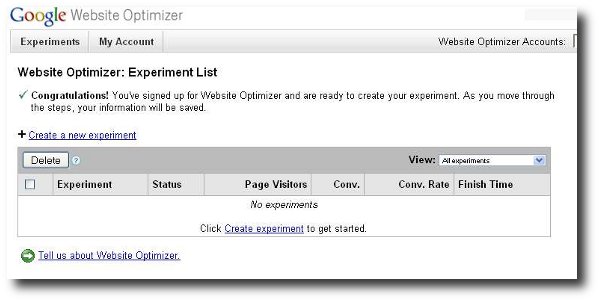
Suppose you have more than one conversion page. Google Website Optimizer tests can track more than one goal. All you do is place the conversion code from your experiment on each of your conversion pages. The caveat is, Website Optimizer only reports one conversion per visitor. Suppose you get a really enthusiastic visitor who buys something and signs up for your newsletter. Website Optimizer will only count one conversion. That way you see which test page gets the most conversions regardless of conversion type.
If you’re doing an A/B test, you’ll make different page versions. They can be totally different if you want. The Optimizer will test their performance to see which one works best. If you’re doing multivariate testing, however, you won’t be able to change the layout of the different sections on your page.
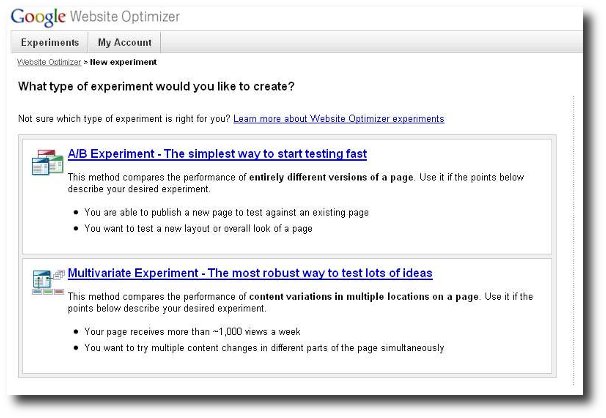
If you already use Google Analytics, you can use Analytics and the Website Optimizer together. If you have customized your tracking scripts for Google Analytics, you’ll most likely want to customize your website optimizer tracking scripts in the same manner. The help center for Google Analytics will show you how to change your Website Optimizer tracking scripts.
There are a few other things to know before using the Google Website Optimizer. For one thing, you have to set up a Google AdWords account. This does not mean that you have to create an AdWords campaign or buy advertising. It’s just that the Optimizer is part of the AdWords interface. You can set up AdWords with a few keywords and some random ad text. When you get to the part where you enter payment details, leave it empty. At this point, you’ll have an AdWords account and will be able to do Website Optimizer tests without buying AdWords ads.
With the A/B test, you are not limited to only two test versions of a page. You can test almost an unlimited number of versions at the same time. The actual number will depend on how many sites you’ve already set up Google Analytics on. All you do is specify more alternative pages when you set up the test. And though you technically can test very different web page designs at the same time, this isn’t recommended. Suppose one page clearly out-performs the other. You won’t know what caused the big change: was it a graphic? headline? something else? You won’t know what to do to other pages to get the same jump in performance. If you take the time to test one-by-one changes, you can see which changes are going to make the most difference.

Google Webmaster Tools is a free service provided by Google to help new and experienced webmaster check on their indexing and raise the visibility of their website(s). Among the tools in Google Webmaster are those that check the crawl rate, list sites linking to the user’s site, determine what keyword searches on Google bring the user’s site into the search engine results pages (SERPs), determine click-through rates of SERP listings, show statistics on how Google indexes the user’s site, create a robots.txt file and submit sitemaps.
The range of tools offered on Google Webmaster Tools can help webmasters significantly raise their profile by search engine optimization (SEO), and traffic generation. To make Google Webmaster Tools work with your particular site, you have to install a snippet of code into your site. Google Webmaster Tools make a great partner to Google Website Optimizer as far as getting your website as prominent as possible.
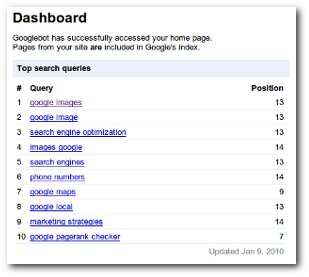 If, for example, your site has a page in which you offer your visitor some free report or software in exchange for their email address, you could use the Google Website Optimizer to test two versions of that page to see which one converts best. This lets you streamline your SEO efforts and cuts back on some of the trial and error part of it.
If, for example, your site has a page in which you offer your visitor some free report or software in exchange for their email address, you could use the Google Website Optimizer to test two versions of that page to see which one converts best. This lets you streamline your SEO efforts and cuts back on some of the trial and error part of it.
Google Webmaster tools was launched in 2006 to help webmasters create sites that are friendlier to search engines. There is also the Google Webmaster Tools Access Provider Program. It lets domain hosts use Google’s application programming interface (API) to get their customers up and running with Google Webmaster Tools.
There are many steps you can take to help Google find, rank, and index your site. They can be classified as Design and Content Guidelines, Technical Guidelines, and Quality Guidelines.
Every site needs a clear hierarchy and text links. Each page needs to be reachable from one or more static text links.
The sitemap should give visitors links to the important pages of your site.
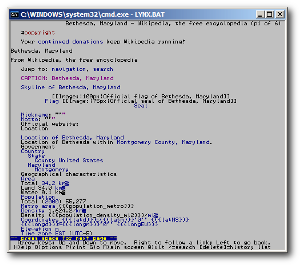 Try out a browser like Lynx to look at your site. Most search crawlers “see” your site like Lynx does. If your site is overloaded with JavaScript, session IDs, Flash, or cookies, the search crawlers may not find your site very navigable.
Try out a browser like Lynx to look at your site. Most search crawlers “see” your site like Lynx does. If your site is overloaded with JavaScript, session IDs, Flash, or cookies, the search crawlers may not find your site very navigable.Before listing the specific practices to avoid, don’t assume that just because a particular practice isn’t listed that it’s OK. If you’re using trickery like registering common misspellings of popular sites, Google might well penalize you in the search engine results pages (SERPs) or ban you altogether. Ultimately, looking for loopholes and technicalities may not serve you well.
When you believe your site is ready and follows all the design, technical, and quality guidelines (especially the latter), then you can submit it to Google at www.google.com/addurl.html. You should also use Google Webmaster Tools to submit a sitemap. A sitemap helps Google cover your webpages more effectively.
Starting up a website can be hard work, particularly if you’re new to the world of style sheets and HTML. It isn’t enough to simply create a great looking site filled with interesting content and wait for people to discover it. Particularly if you have an e-commerce site or a blog from which you want to earn money, you need to make your site as friendly as possible to search engines. Google Webmaster Tools are specifically for this purpose: getting your website the notice that it deserves.
While it may be tempting to take shortcuts like buying a bunch of back links, it can be bad for your site in the long run. The best way to build your site’s following is to submit a sitemap, and follow the guidelines listed above for proper ways to promote your site. And, of course, the ultimate “tool” for getting your site popular and keeping it popular is to provide fresh, rich content on a regular basis.

Statistics from early 2009 claimed that iPhone users accounted for some two-thirds of all mobile browsers. Now, while that particular statistic has been questioned and debated, there is little doubt about the effect of the iPhone on mobile browsing. The advent of the Google Android phone will only make mobile web surfing more mainstream than it already is. When it comes to optimizing your web content for Google Mobile Search, there are a number of things you can do.
Some people say that you should make a mobile version of your regular website, while other say that you should optimize your existing site for mobile browsing. But whether it’s your normal site optimized for mobile, or a new mobile version of your site, there are steps that anyone wanting to rank high in mobile search results should do.
 Step one is to make sure that your website is mobile compliant. This means that your pages are formatted for people browsing the web with their phones. Mobile browsing implies a lack of time to complete a search. Perhaps instead of mobile “browsing,” the term should be something more like mobile “hunting.” But since mobile users are also short on screen space, the pages should be designed to cater to this reality. Do you know what your site looks like on a mobile web platform? If not, do a mobile search to see. You’ll notice that a lot of your site’s goodies are unavailable. But this makes some choices all the more obvious.
Step one is to make sure that your website is mobile compliant. This means that your pages are formatted for people browsing the web with their phones. Mobile browsing implies a lack of time to complete a search. Perhaps instead of mobile “browsing,” the term should be something more like mobile “hunting.” But since mobile users are also short on screen space, the pages should be designed to cater to this reality. Do you know what your site looks like on a mobile web platform? If not, do a mobile search to see. You’ll notice that a lot of your site’s goodies are unavailable. But this makes some choices all the more obvious.
If these things don’t check out, then you need to make some changes to get your site ready for what many experts see as the coming tsunami of mobile searching.
Why should you go to the trouble? The current industries seeing the most growth in mobile searches are business, entertainment, and travel. According to the Mobile Optimization Association, mobile searchers tend to be young, high income professionals with promising careers, or, to put it more bluntly, people with more disposable income than usual.
Web pages for mobile browsing are created in XHTML or WML. They must be W3C compliant. W3C stands for “World Wide Web Consortium” and sets guidelines about how a web page should be structured. They publish best practice design principles for webmasters. Without going into the nuts and bolts of getting your site to be W3C compliant, you should know that there is a W3C Code Validator at http://validator.w3.org/ that anyone can use to ensure that your site renders on all the major browsers and platforms in a similar manner.
Before deciding exactly how to optimize your site for mobile, there are a few things to know about the people who use mobile browsers. First of all, they tend to use the same search engine on their mobile device as they use on their PC. Even though there are 234 million wireless subscribers in the U.S., only 10% use mobile search (which is still 23 million people). Adoption rates of mobile browsing are much higher in Europe. Finally, mobile searchers are goal-oriented: they want to get the info and get out. They don’t tend to browse or surf.
A few general practices for optimizing your site are:
There are two main opinions when it comes to optimizing your site for Google Mobile: 1) Optimize your existing site; and 2) Create a new mobile-only site. Both approaches have their advantages and disadvantages, which we’ll go into next.
If you want to optimize your existing site, make sure that in mobile search your pages are independent of device. Search results on mobile devices use a different data set than web browsers do.
Use external CSS style sheets because they limit how much code has to be downloaded and are helpful in scaling up or down for different screen sizes. You can have a separate style sheet for hand held devices.
Use text links rather than images. Images may not download at all and will increase page loading times. Here are a few do’s and don’ts for optimizing an existing site for mobile search.

The argument for doing this is that mobile users are goal oriented rather than simply browsing. Some sites have taken to using a subdomain approach rather than using a separate domain like .mobi. That would give your mobile site a name like mobile.yourdomainname.com. It allows you to retain the “brand” of the top level domain rather than having to rebuild branding for a new domain name. Here are some tips for optimizing a mobile-only version of your site.

The relationship between targeted traffic and search engine ranking page (SERP) position shows that search engine optimization, or SEO, treads a fine line between being an art and being a science. Obviously there are specific algorithms that are used to rank sites for a given search query, but finding out exactly how they work is shrouded in mystery.
Even without, say, Google giving up how its search engine ranking is determined, every time there is a new factor taken into account by an algorithm, SEO researchers are pretty quick to learn in general what that new factor is, and less scrupulous site owners are ready to pounce with less than honest ways to try and game the system.
One fairly recent example is back links. Once it became general knowledge that search engine ranking and Google PageRank took back links into account, “link farms” and sites where you could buy links sprung up like so many mushrooms after a rainy spell. It was then Google’s turn to ferret out sites using these techniques and either de-list them or drop their rank significantly.
It’s like an arms race: as soon as people figure out and exploit some “new” wrinkle in SERP generation, the search engines have to find a way to stamp dishonest practices out. Otherwise, the search engines aren’t worth much to people doing real searches. This arms race continues because making it onto the first page of search results is good, making it “above the fold” (in the upper 700 or so pixel rows) is better, and ranking number one is best.
In 2006, some AOL search engine ranking data was leaked, and SEO researchers pounced. The analysis showed that the number one position brings with it a 47% average click through rate. Positions two, three, and four have click through rates of 13%, 9%, and 7%. Clearly, bringing your ranking up from third or fourth to first makes an enormous difference in a site’s traffic and its bottom line if it is a commercial site.
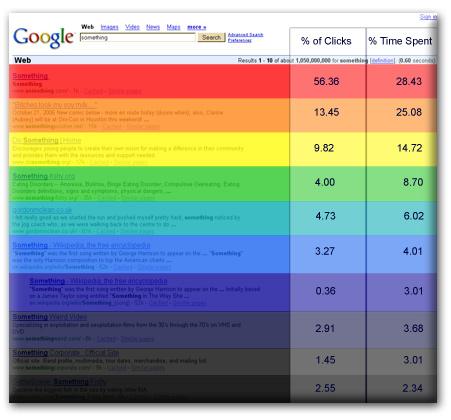 Of course, these figures are only approximations, but they do seem to hold water. People notice great differences between their statistics between the top rankings. Anecdotal evidence suggests that going from the #2 to the #1 spot can increase traffic by 100% or better. Dropping from #1 to #2 corresponds to a 30% to 50% drop in search volume.
Of course, these figures are only approximations, but they do seem to hold water. People notice great differences between their statistics between the top rankings. Anecdotal evidence suggests that going from the #2 to the #1 spot can increase traffic by 100% or better. Dropping from #1 to #2 corresponds to a 30% to 50% drop in search volume.
As you move downward through the first SERP, the rate of decline of click throughs falls, and one interesting quirk that could be an artifact is that the number 10 position gets a slightly higher rate of click throughs than the number 9 position. Some speculate that users will be more likely to glance at the last listing while scrolling down to suggest searches or page navigation buttons. Once you move off the first SERP you’re close to being invisible. For all but the very highest volume queries, the non first SERP listings will generally offer no benefit to site owners except in unusual situations.
A factor in your SERP position is the quality of your site’s meta data. To ensure that your web pages get the best shot at appearing high in the search engine results, you need to give some thought to the meta data in your web pages. Meta data is data describing other data. For your web page, meta data includes things like the page title, keywords, and description.
In Google, the display of a “snippet” of your site will be longer, the longer the query is leading to the site. In other words, a detailed query that hits your site will sometimes show a three line snippet rather than the traditional two line snippet. The main reason this makes a difference is that it can in some cases limit the results shown “above the fold” to the top three results rather than four.
As you can see in the accompanying screen shot, a search on “chloe light gray leather riding boots” results in a long snippet for the top result, though the others in the top ten are still short snippets.
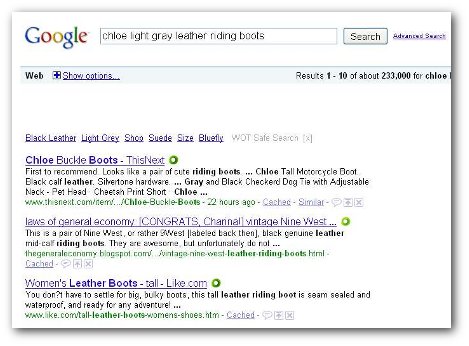
A good snippet can improve click through rates, and you can be sure that if extended snippets cause only three listings to show above the fold, then position in the top three results becomes even more important. In other words, yes, people are too lazy to scroll down in many cases.
Now, while the extended snippets come from actual content of the page it refers to, meta data is used in other cases. A well-optimized page has a title containing the target keyword phrase, and the keyword phrase from the title (with slight variations) should be made of phrases most used to find your page in the SERPs. Putting all the title keywords into the meta description will maximize the number of times your meta description is shown as your snippet. If the meta description contains all of the keywords from the user’s search phrase, it will be used as the search snippet for your page.
The meta description should also contain, if possible, a call to action that will make the user want to click on through to your site, and the description should be accurate so that the user doesn’t jump right back to the SERP from your site. A well optimized meta description, title, and a URL that is rich in keywords can all work together to boost your click through rate even if your site is ranked third or fourth rather than first on the SERP.
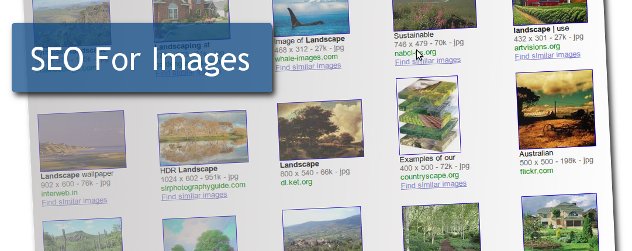
If you have ever used Google Image Search then you are already indirectly familiar with search engine optimization for images. You type in “stainless steel gardening fork” to Google Image Search, and you get a page full of pictures of stainless steel gardening forks. There are a number of reasons to optimize your website for Google Image Search.
The main reason is that Google Image Searches can bring your site a lot of traffic, particularly if your image shows up on the first page of results and is heavily searched. So, having your site on the first page for “stainless steel gardening fork” won’t get you the boost in traffic that, say, a first page hit on “world cup 2010” would. In fact there are some sites get most of their traffic through Google Image Search.
A second reason to optimize your page for Google Images is that it helps to define the overall look and feel of your page. Optimization helps you rank higher in regular search engine rankings and display more relevant AdSense ads if you participate in AdSense. Optimizing involves arranging things so that the Google Image Bot can easily interpret what your site is all about, since it can’t “see” your images.
It is important to note that the Google Image Bot crawls the web to index images like the regular Google Bot indexes pages. The Google Image Bot is slower, however, and doesn’t visit sites as frequently as the regular Google Bot indexes sites. It could take as long as one year for the Image Bot to visit your site, which means that optimizing a site for Google Images takes a long time.
But it’s still worth it. Go ahead and optimize your site for Google Images so that when that Image Bot finally does pay a visit, you’ll have the best chance of ranking high in the Image Search results. Once you look in your server logs and see “images.google.com,” you’ll know that your site has been indexed for Google Images.
To help make your visit from the Image Bot go as well as possible, you need to know that it relies on several factors to figure out what an image is about. Those factors include: the file name, the alt text, the surrounding text, the page title, the page theme, and links. The alt text and file name are the most important in the Bot’s determination of what an image is about.
 The alt text is what shows up when you hover your mouse over an image. In your image code, you use this bit of html:
The alt text is what shows up when you hover your mouse over an image. In your image code, you use this bit of html:
<img src=”filename.gif” alt=”Alternative description goes here“>
You should be descriptive, but you don’t have to go overboard with it. Choose a description that represents what you would be searching on if you were looking for that image. Leave out words like “the, or, and, are, we” and similar ones. They’ll do little but take up space that better descriptors could be using. In other words, you should use something like “horseshoe crab Seabrook Island South Carolina” rather than “the horseshoe crab I found that time.”
The same principle applies to your image file name. Don’t call it pic081204.jpg. Call it horseshoecrabseabrook.jpg. Keep the file name either the same as or similar to the alt text. Cramming different keywords into the alt text and file name will not help you rank higher. It will only confuse the Image Bot.

The path to your image should be logically themed as well. It should be something like “mydomain.com/images/animals/horseshoecrabseabrook.jpg” rather than “mydomain.com/stuff/awesome/horseshoecrabseabrook.jpg“. On your page, if you put a paragraph of descriptive text just above and just below your image, and the text contains the key phrase from your alt text and image name, you have a much better chance of your image being indexed well.
If you can (and sometimes you just can’t), put your keywords into your page title and your page meta description. The more consistent the data that Google gets concerning your image, the better the indexing will be. This applies to your regular page optimization as well as that for images, and it will also result in more pertinent Adsense ads if you participate in AdSense.
When it comes to images and to your site’s pages in general it’s best to keep every page relevant to its own theme. In other words, leave your images and text about wildlife photography techniques on its own page rather than mixed in with your image and description of the horseshoe crab.
If you have a page for each topic and optimize each page, you can then use the trick of placing Adsense ads on the page to see if Google “gets” what your page is all about. Even if you don’t want to participate in AdSense, you can try this as an indicator of what your site is perceived by Google as being about.
As with your regular pages, back links help your image rank higher as long as they were obtained in an organic and honest manner. If you use text links with anchor text, use your key phrase as the anchor. In other words “click here to see horseshoe crab from Seabrook” is much better than “click here to look at a cool picture I took”. And, as usual, the more descriptive your URL, the better.
One final tip is to be aware that Google wants to provide unique content in image form just as it does with web pages. To do this it tries to match up the image file size, dimensions of the image in pixels x pixels format, and the image file name. Therefore, if you get an image from another site (with permission of course), you should alter the file name, file type, file size, or image dimensions so that Google doesn’t flag it as duplicate content. As you can see in the screen shot, all these front page results are different.

Former U.S. Representative Tip O’Neill’s famous quote that “All politics is local” can in some cases be applied to internet searches. What it means is, never lose touch with your constituents, or in the case of a business, your customers. If you have a bricks and mortar business and don’t sell online, then in your case, “all search engine optimization is local.” Local customers often search for local listings, whether for simply the phone number, store hours, or just to find out more about local businesses. If you don’t optimize your site for local searches, you could be losing more business than you think.
Google Local Business listings usually only show up when the user types in a category of business and a city. When that happens, Google Maps shows up along with anything up to 10 URLs listed next to their phone numbers. You don’t want your competitors to show up on that map with their phone numbers if you aren’t showing up there. If you are, for example, a cosmetic dentist in Atlanta, you want local people to find your practice in as many ways as possible: from offline ads, yellow pages, or online searches.
Look at the screen shot for this very search, “cosmetic dentists atlanta.” As you can see, several practices are listed, their locations are shown on a map, and their phone numbers are right there. There are plenty of things you can do as a business owner to get local people to find your website and your actual business. For one thing, you can ask for back links to your business from other prominent sites.
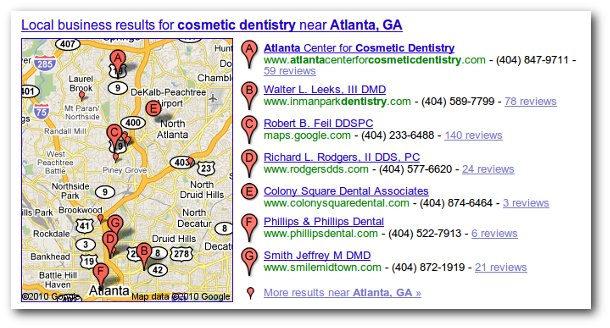
For an example in keeping with the cosmetic dentists in Atlanta theme, suppose you, the cosmetic dentist, were to type in “cosmetic surgery atlanta.” You’d get a page like this second screen shot. Suddenly you see, in this case, seven local cosmetic surgery practices from whom you could possibly solicit back links and offer your own back link to their site. Back links aren’t everything, but they are important in the world of search engine results.
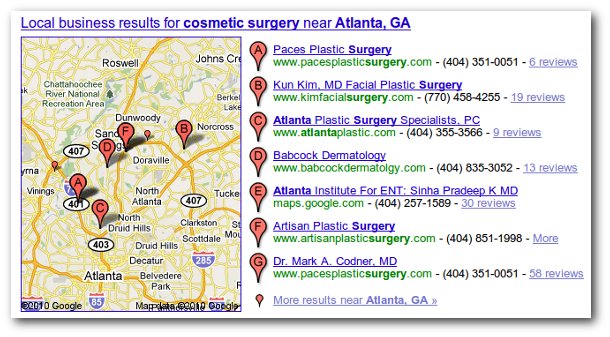
List your business and website in as many free online directories as possible. There is evidence that Google may use your business’s phone number to boost your local ranking, so any time you write a description of your business on a third party site, include the phone number. Also, make sure that all your business listings are as complete and consistent as possible.
If you can include images, coupons, or even a video along with the basic name, address, phone number, and business hours information, so much the better. Use good keywords in your directory listings too. For example, in this instance, good keywords might include “veneers, laser whitening, dental makeover” while the keyword “teeth” would be too broad and vague to help you much.
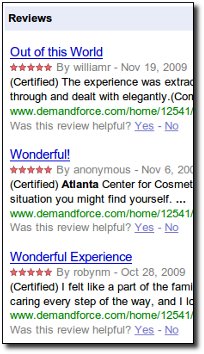 And there’s nothing wrong with looking at those local businesses that rank at the top and looking at what they’re doing in their local listings. They may be doing something you hadn’t thought of, like offering a coupon on their website. Another important factor in optimizing your site and listings for Google Local is customer reviews. Put a link from your site’s home page to a directory listing and encourage customers to review your business. The more reviews you get, the better.
And there’s nothing wrong with looking at those local businesses that rank at the top and looking at what they’re doing in their local listings. They may be doing something you hadn’t thought of, like offering a coupon on their website. Another important factor in optimizing your site and listings for Google Local is customer reviews. Put a link from your site’s home page to a directory listing and encourage customers to review your business. The more reviews you get, the better.
In your website itself, include your business name in the title tags, description, and content. Make sure that your site contains the address and phone number on every page as well as city and state in content, titles, headers, and descriptions.
Claim and verify your business in the Google Local Business Center, and ensure that the information is correct in data providers like YellowPages, Localize, Acxiom, and InfoUSA. These data providers supply many online business directories. If your business has recently moved or changed its phone number, make sure inconsistencies in all listings are fixed. You want all your listings to contain the correct and up-to-date information about your business.
Be sure to claim and verify your listing in directories. You would be surprised how many businesses don’t do this. Gain the upper hand by getting there first. Proper categorization of your business in Google Maps can make an enormous difference to the success of your local business listing. Make the mandatory category describe accurately what your business does. Reserve a few of the fields for custom categories that might be unique to your business. Keep your categories from overlapping to get the most mileage from them, and keep categorizing consistent in directory listings and anywhere else on the web such information is found.
With Google Maps, the description field should state what it is that sets your business apart and makes it the one people should trust. You only have 200 characters in which to do this, so you have to be brief: do you have a patent on a technique you use? is your business the oldest of its kind in town? Capitalize on what sets you apart.
You are allowed to add 10 images and 5 videos to your listing, and you should take advantage of this. Pictures that work well for your listing are your business logo, brands you carry, pictures of your business, and logos or badges of associations you belong to, like the local chamber of commerce or the Better Business Bureau. You can even include videos of your commercials or interviews you may have done on local television!
Put your business’s name out there on as many internet yellow page (IYP) sites, niche directories, local business directories and other trusted sites as possible. Mentions of your business information on several places on the web will help optimize your Google Local listing. If you haven’t taken these steps toward optimizing your Google Local listing, take the time to do so. Chances are you’ll see a real improvement in both web and real-world traffic to your business.
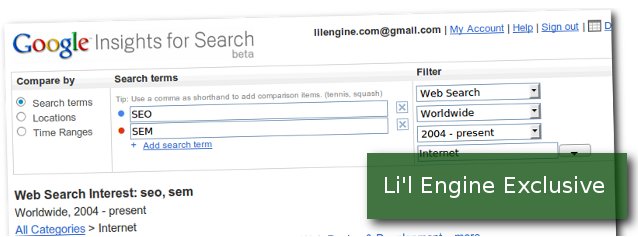
In August 2008 Google launched its tool called Google Insights for Search. It’s like Google Trends on steroids. There are many new features designed with advertisers and marketing professionals in mind to help them (and anyone else who is interested, such as the average website owner) understand search behavior.
Google Trends displays how frequently a search term is queried in relation to the total search volume throughout all regions of the world in different languages. Google Trends produces a graph where the horizontal axis shows a simple timeline (which goes back to 2004), and the vertical axis is how often a term gets searched for devided by the total number of searches worldwide. It also produces popularity broken down by location and language.
Google Insights is a more sophisticated tool to help people gauge interest in relevant search terms. For example, Google Insights can help you figure out which messages go over best. Suppose you make high-end espresso machines. You can use Google Insights to determine whether your advertising should highlight money savings over coffee shop coffee, taste test results, or performance and features. Google Insights can also be used to determine seasonal variations in search behavior and to help advertisers and marketing professionals create more effective brand associations.
As just a quick example, typing the search terms “espresso,” “home espresso machine,” and “gourmet coffee” in the category “Food & Drink” for 2009 yields the data you can see in the first screen shot. when you look at the graph of “Growth Relative to the Food & Drink Category” you can see that it takes a big jump in December that is most likely due to Christmas shopping. Looking at the terms by region, you can see that Greece, Netherlands, and Germany are the regions that searched most on “espresso.” The only blip at all for the term “gourmet coffee” comes from the United States, and it’s very small.
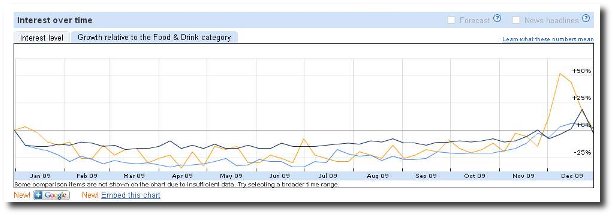
But you can also learn that the top three searches of related terms are “coffee espresso,” “espresso machine,” and “cafe espresso.” The top three rising searches are “espresso on line” (popular in Italy), “espresso apparaten” (tops in Netherlands), and “cowgirl espresso” (the most popular in the U.S.). With this information I could zero in on Greece, Italy, and Netherlands and try to get to the heart of the popularity of the search terms there.
You are not limited to Google web searches. You can also analyze results from Google News, Product Search, and Image Search. You can break the data down even further from there. For example, you could look at hot Google News searches over the past week, month, or quarter. Queries can be broken down by region into individual metropolitan areas. This is a tool that news journalists find helpful in gauging interest levels in different subjects among their readership base.
One researcher gauged the interest of the U.S. college basketball tournament known as “March Madness” for a period of one week during March 2009. The results showed that interest was highest in the states of Kentudky, Iowa, and Kansas. In 2010, journalists could gauge popularity of search terms related to the World Cup in South Africa in various regions around the world. In a nutshell, what Google Insights does is help anyone who is interested (webmaster, ad agency, small business owner, academic researcher, or otherwise interested party) measure interest in search terms relative to their particular area of research.
Suppose, for example, you have a seasonal business, perhaps a surf shop in Torquay, Australia. While you know that your peak business will occur in January through March, maybe you want to know when people start querying about surfing holidays in Australia. If you plug “surfing Australia” and “surfing holidays Australia,” you’ll discover that with the exception of 2004, there are peaks of interest at the beginning and end of each year as one might expect. This can be seen in the second screen shot.
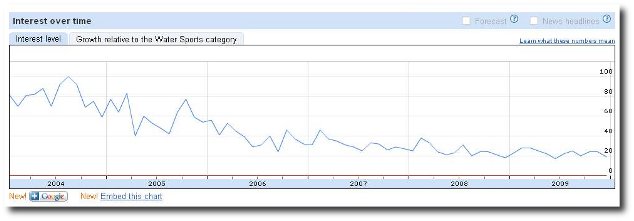 But scroll down further and you can see that the rising searches include “rip curl australia,” “asp surfing australia,” and “surfing in australia.” Further probing shows that Victoria is the state with the most searches, and Melbourne is the city with the most searches on “rip curl australia.” So as the theoretical owner of a Torquay surf shop, I may decide to pitch my advertising especially aggressively in Melbourne.
But scroll down further and you can see that the rising searches include “rip curl australia,” “asp surfing australia,” and “surfing in australia.” Further probing shows that Victoria is the state with the most searches, and Melbourne is the city with the most searches on “rip curl australia.” So as the theoretical owner of a Torquay surf shop, I may decide to pitch my advertising especially aggressively in Melbourne.
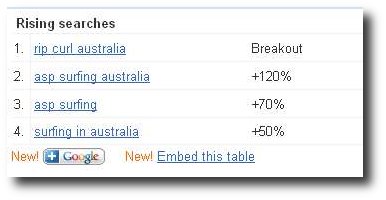 You can use Google Insights to flesh out keyword ideas and perhaps tweak any Adwords Campaigns you’re running. You can download the results to a spreadsheet for convenience. To download data to spreadsheets you will have to sign into your Google account. Google Insights is available in 39 languages, and will soon add a forecasting feature that will be available for some queries. An Animated map function will allow Google Insights users to see how interest changes with time and location.
You can use Google Insights to flesh out keyword ideas and perhaps tweak any Adwords Campaigns you’re running. You can download the results to a spreadsheet for convenience. To download data to spreadsheets you will have to sign into your Google account. Google Insights is available in 39 languages, and will soon add a forecasting feature that will be available for some queries. An Animated map function will allow Google Insights users to see how interest changes with time and location.
Google Insights is a flexible enough tool that users can think of countless ways to use it. Beyond just expanding your keyword lists or looking at economic trends, you can use it for things like satisfying your curiosity about why some other site ranks higher in the search engines than yours. Even historians of the post-2004 era will find a wealth of information about how search queries evolve over time and across world regions.
Small business owners, ad agencies, and marketing specialists can use Google Insights to compare brands in real time over real markets. If there is a clear indication that a particular ad campaign is working well in a particular region or city, they can more accurately target offline advertising and even promotional events. Research using Google Keyword Tool has shown that search volume estimates are reasonably accurate, particularly in terms of relative value. That means that you can have a healthy amount of trust in the results you get from using Google Insights.